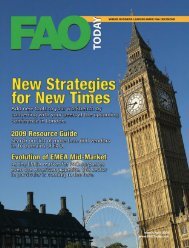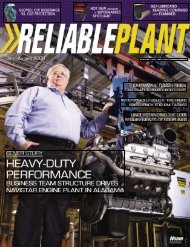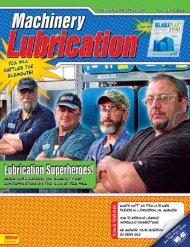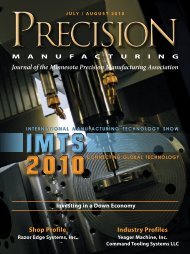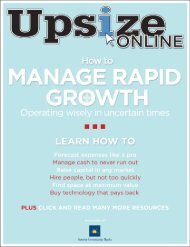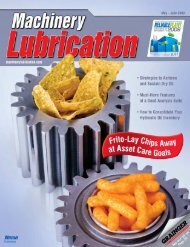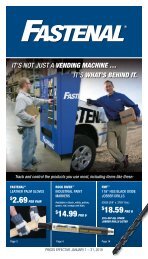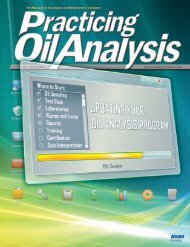Machinery Lubrication July August 2008
Machinery Lubrication July August 2008
Machinery Lubrication July August 2008
You also want an ePaper? Increase the reach of your titles
YUMPU automatically turns print PDFs into web optimized ePapers that Google loves.
in the area and inadequate grounding or insulation.<br />
It may also be referred to as electrical<br />
pitting, arcing or sparking.<br />
Current leakage (electrical fluting) is a less<br />
severe form of damage caused by a lower<br />
continuous electrical current. The damage<br />
may be shallow craters that are closely positioned<br />
and appear dark gray in color. If the<br />
electrical discharge occurs while the bearing is<br />
in motion, with a full fluid film, a washboard<br />
effect or grooves appear on the entire bearing<br />
raceway and is called fluting or corduroying.<br />
Plastic Deformation<br />
This is the denting, indentations or depressions<br />
in the race or rollers caused by impact or<br />
overloading. The surface metal flows, causing<br />
irreversible deformation (not wear). The<br />
machining marks are still visible in the bottom<br />
of the dent. The dents often have a raised lip<br />
which increases stresses and leads to surfaceinitiated<br />
fatigue (surface cracks) and eventual<br />
pit formation or adhesive wear. Plastic deformation<br />
consists of three subcategories.<br />
Overload or true brinelling is characterized<br />
by static or shock loading, or impact from<br />
operational abuse, causing a permanent dent<br />
in the metal without cutting or welding of the<br />
metal. An example occurs in roller bearings<br />
when impact causes the rollers to create a<br />
series of dents in the bearing race surface at<br />
intervals that match the roller spacing exactly.<br />
Some people consider denting from the<br />
impact of hammering on a bearing as overload;<br />
others may consider it as an indentation<br />
from handling.<br />
Indentation from debris is a form of plastic<br />
deformation but it is caused by a particle<br />
trapped within the dynamic clearances<br />
between two machine elements and being<br />
over-rolled. The force causes a round-bottom<br />
dent to form in the race or rolling element.<br />
Cracks may propagate down into the metal.<br />
Indentation from handling is similar to<br />
that from debris, but results from a bearing<br />
being dropped or hammered, causing localized<br />
overloading. It can also be due to nicks<br />
from hard or sharp objects.<br />
It is common to encounter erosion from<br />
particles in the oil and cavitation, although<br />
this is not included in the ISO standard for<br />
rolling bearings.<br />
Erosion<br />
Erosion could be considered a form of abrasive<br />
wear. It occurs principally in high-velocity,<br />
fluid streams where solid particle debris,<br />
entrained in the fluid (oil), impinges on a<br />
surface and erodes it away. Hydraulic systems<br />
are an example where this type of wear may<br />
occur. Flow rates have a significant influence<br />
on these wear rates, which are proportional to<br />
at least the square of the fluid velocity. Erosion<br />
typically occurs in pumps, valves and nozzles.<br />
Metal-to-metal contact does not occur. The<br />
mechanism of erosion is used to an advantage<br />
in water-jet cutting.<br />
Cavitation<br />
This is a special form of erosion in which<br />
vapor bubbles in the fluid form in low-pressure<br />
regions and are then collapsed<br />
(imploded) in the higher-pressure regions of<br />
the oil system. The implosion can be powerful<br />
enough to create holes or pits, even in hardened<br />
metal if the implosion occurs at the<br />
metal surface. This type of wear is most<br />
common in hydraulic pumps, especially those<br />
which have restricted suction inlets or are<br />
operating at high elevations.<br />
Restricting the oil from entering the pump<br />
suction reduces the pressure on the oil and,<br />
thus, tends to create more vapor bubbles.<br />
Cavitation can also occur in journal bearings<br />
where the fluid pressure increases in the load<br />
zone of the bearing. No metal-to-metal<br />
contact is needed to create cavitation.<br />
Just to be clear, pitting is a general term<br />
used in failure analysis to describe almost any<br />
small, rough-bottomed, circular potholes in<br />
the metal surface. Pits can be caused by<br />
mechanical pitting (fatigue or cavitation),<br />
chemical pitting (corrosion) or by electrical<br />
pitting (stray arcing), all of which are<br />
described above.<br />
<strong>Machinery</strong> <strong>Lubrication</strong> machinerylubrication.com <strong>July</strong> - <strong>August</strong> <strong>2008</strong> 39



